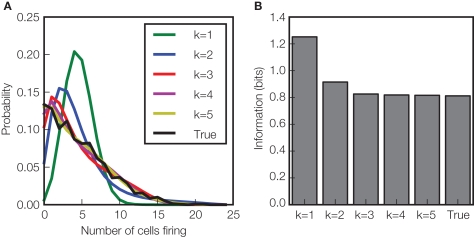Figure 3.
Effect of higher order correlations on response distributions and information transmission. This figure illustrates the potential role of high order interactions in shaping the response distributions and the amount of information about the velocity of whisker deflection carried by population of neurons in rat somatosensory cortex (Montani et al., 2009). (A) The probability of the number of cells firing in a population of neurons (recorded simultaneously from 24 locations) in response to stimulus velocity 2.66 mm s−1 during the [5–25] ms post-stimulus time window. The experimentally observed “true” probability distribution (black line) is compared to that of a maximum entropy probability model, preserving all interactions up to order k (k = 1,…5), but imposing no other interactions of order higher than k. Clearly, the model discarding all interactions (k = 1) gives a distribution very far from the real one. Including interactions across neurons (k > 1) improves the fit dramatically, and including interactions of order 3 is enough to get a statistically acceptable fit (χ2, p < 0.05). (B) To investigate the effect of the interactions on information, we simulated a system with these maximum entropy stimulus conditional distributions, generating the same number of trials as were available in the experimental data set. The information in this hierarchical family of model systems (averaged over 1000 simulations) is plotted and compared to the information carried by the “true” distribution observed experimentally. Correlations of order three are required to match the information carried by the true neural population responses, but fourth order and above had no effect on the information transmitted. Data from Montani et al. (2009) were redrawn and reanalyzed to create this figure.

